Hospitality Industry's Role in Travel and Tourism: A Detailed Report
VerifiedAdded on 2020/10/05
|13
|4239
|72
Report
AI Summary
This report provides a comprehensive analysis of the hospitality industry's role within the travel and tourism sector. It begins by defining hospitality and its scope, highlighting its significance in economic growth and job creation. The report then examines the integration strategies employed by companies like Thomas Cook and Marriott, exploring both vertical and horizontal integration models. Key aspects such as the impact of integration on standardization, economic scale, and quality are discussed, along with how organizations respond to the consequences of these changes. The report further outlines the rationale for new hospitality businesses, including product and service concepts, and concludes with an overview of the challenges and opportunities within this dynamic industry. It covers various aspects of the hospitality industry, including lodging, food services, and customer service, and emphasizes the importance of employee training and customer satisfaction. The report also explores the impact of integration on market dynamics and the strategies companies use to maintain their position in the competitive landscape.
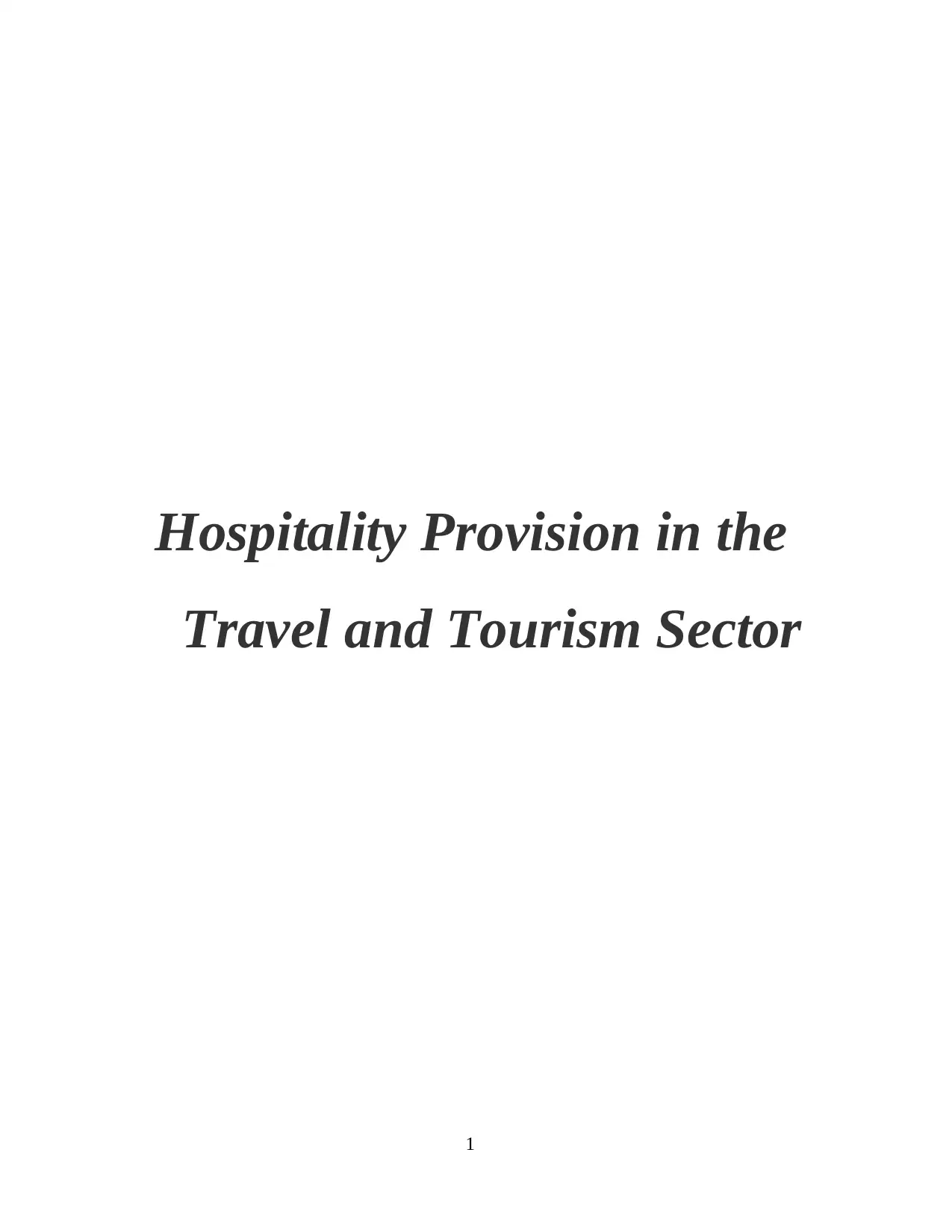
Hospitality Provision in the
Travel and Tourism Sector
1
Travel and Tourism Sector
1
Paraphrase This Document
Need a fresh take? Get an instant paraphrase of this document with our AI Paraphraser

Table of Contents
INTRODUCTION:.............................................................................................................................3
TASK 1...............................................................................................................................................3
1.1 Scope and scale of hospitality industry within travel and tourism sector and analyse its role
in organisation ...............................................................................................................................3
TASK 2...............................................................................................................................................4
2.1 Integration in hospitality sector organizations and examine with example.............................4
2.2 Impacts of integration and how the organisation decides to respond to
the consequences of integration....................................................................................................6
TASK 3...............................................................................................................................................7
3.1 & 3.2 Rationale of new hospitality business outlining product service concept and project
proposal..........................................................................................................................................7
CONCLUSION: ..............................................................................................................................11
REFERENCES:................................................................................................................................12
2
INTRODUCTION:.............................................................................................................................3
TASK 1...............................................................................................................................................3
1.1 Scope and scale of hospitality industry within travel and tourism sector and analyse its role
in organisation ...............................................................................................................................3
TASK 2...............................................................................................................................................4
2.1 Integration in hospitality sector organizations and examine with example.............................4
2.2 Impacts of integration and how the organisation decides to respond to
the consequences of integration....................................................................................................6
TASK 3...............................................................................................................................................7
3.1 & 3.2 Rationale of new hospitality business outlining product service concept and project
proposal..........................................................................................................................................7
CONCLUSION: ..............................................................................................................................11
REFERENCES:................................................................................................................................12
2

INTRODUCTION:
Hospitality industry and travel tourism are responsible the growth of economy of industry.
They provide accommodation and food and services to customers and is playing a vital role in
travel and tourism sector. International tourism has reached to 842 million in 2006. Similarly,
passenger transport range has also improvised and increased up to 883 billion that indicates that
foreign visitors has increased by $2.4 billion per day (Alfaro and et.al., 2016). It is the major
source of employment and has been ranked number one industry all over the world. In developing
as well as developed areas its services have been growing. It includes lodging, food services,
cruises, marketing, finance, customer service, casinos. Youngsters like to take education for
aspiring posts. Various types of jobs exist in different parts of the country. This report presents
scope, integration of Thomas Cook and Marriott Company and shows affect of horizontal and
vertical integration on this sector.
TASK 1
1.1 Scope and scale of hospitality industry within travel and tourism sector and analyse its role in
organisation
Hospitality is defined as one of crucial sector which varies from other industries and takes
care of customers. It brings money, placements and many other opportunities. Employees and
managers in this sector are well-qualified and trained in human resources and customer service. It
is important for staff to coordinate with guests which provides them excellent experience. Scope of
hospitality relates to career development and rise in economy. Various types of career can be
pursued with a degree. Employees working there are categorised by lodging manager, restaurant
manager, cruise director, concierge, travel agent, facilities manager and many more. Consumer
will only choose a hotel which provides best service (Andringa, Poulston and Pernecky, 2016).
Travel and tourism consists of all services like travelling, food etc. Customer service of Thomas
Cook is widely spread all over the world. In UK many unemployed people are benefited with
skilled and management roles. Around 106,300 people have replaced those who left jobs. 89% of
the workforce is analysed to be of this sector. Thomas Cook is employing much younger
workforce all across the world. Contract food and catering industry have also shown great growth.
This sector has contributed to all industries and has increased businesses to 3# while travel
service decreased to 8%. Core part of hospitality sector are hotels, catering and event management.
3
Hospitality industry and travel tourism are responsible the growth of economy of industry.
They provide accommodation and food and services to customers and is playing a vital role in
travel and tourism sector. International tourism has reached to 842 million in 2006. Similarly,
passenger transport range has also improvised and increased up to 883 billion that indicates that
foreign visitors has increased by $2.4 billion per day (Alfaro and et.al., 2016). It is the major
source of employment and has been ranked number one industry all over the world. In developing
as well as developed areas its services have been growing. It includes lodging, food services,
cruises, marketing, finance, customer service, casinos. Youngsters like to take education for
aspiring posts. Various types of jobs exist in different parts of the country. This report presents
scope, integration of Thomas Cook and Marriott Company and shows affect of horizontal and
vertical integration on this sector.
TASK 1
1.1 Scope and scale of hospitality industry within travel and tourism sector and analyse its role in
organisation
Hospitality is defined as one of crucial sector which varies from other industries and takes
care of customers. It brings money, placements and many other opportunities. Employees and
managers in this sector are well-qualified and trained in human resources and customer service. It
is important for staff to coordinate with guests which provides them excellent experience. Scope of
hospitality relates to career development and rise in economy. Various types of career can be
pursued with a degree. Employees working there are categorised by lodging manager, restaurant
manager, cruise director, concierge, travel agent, facilities manager and many more. Consumer
will only choose a hotel which provides best service (Andringa, Poulston and Pernecky, 2016).
Travel and tourism consists of all services like travelling, food etc. Customer service of Thomas
Cook is widely spread all over the world. In UK many unemployed people are benefited with
skilled and management roles. Around 106,300 people have replaced those who left jobs. 89% of
the workforce is analysed to be of this sector. Thomas Cook is employing much younger
workforce all across the world. Contract food and catering industry have also shown great growth.
This sector has contributed to all industries and has increased businesses to 3# while travel
service decreased to 8%. Core part of hospitality sector are hotels, catering and event management.
3
⊘ This is a preview!⊘
Do you want full access?
Subscribe today to unlock all pages.

Trusted by 1+ million students worldwide
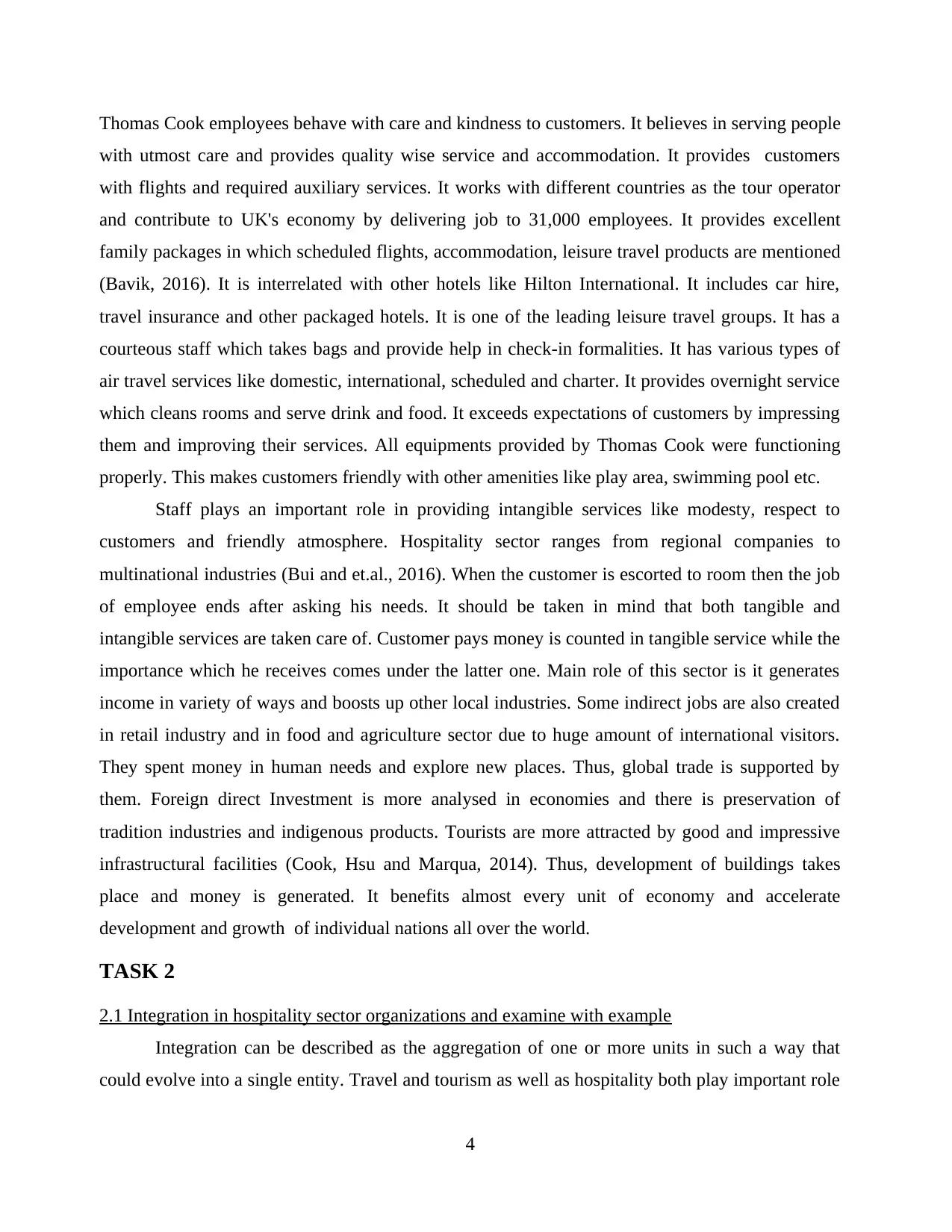
Thomas Cook employees behave with care and kindness to customers. It believes in serving people
with utmost care and provides quality wise service and accommodation. It provides customers
with flights and required auxiliary services. It works with different countries as the tour operator
and contribute to UK's economy by delivering job to 31,000 employees. It provides excellent
family packages in which scheduled flights, accommodation, leisure travel products are mentioned
(Bavik, 2016). It is interrelated with other hotels like Hilton International. It includes car hire,
travel insurance and other packaged hotels. It is one of the leading leisure travel groups. It has a
courteous staff which takes bags and provide help in check-in formalities. It has various types of
air travel services like domestic, international, scheduled and charter. It provides overnight service
which cleans rooms and serve drink and food. It exceeds expectations of customers by impressing
them and improving their services. All equipments provided by Thomas Cook were functioning
properly. This makes customers friendly with other amenities like play area, swimming pool etc.
Staff plays an important role in providing intangible services like modesty, respect to
customers and friendly atmosphere. Hospitality sector ranges from regional companies to
multinational industries (Bui and et.al., 2016). When the customer is escorted to room then the job
of employee ends after asking his needs. It should be taken in mind that both tangible and
intangible services are taken care of. Customer pays money is counted in tangible service while the
importance which he receives comes under the latter one. Main role of this sector is it generates
income in variety of ways and boosts up other local industries. Some indirect jobs are also created
in retail industry and in food and agriculture sector due to huge amount of international visitors.
They spent money in human needs and explore new places. Thus, global trade is supported by
them. Foreign direct Investment is more analysed in economies and there is preservation of
tradition industries and indigenous products. Tourists are more attracted by good and impressive
infrastructural facilities (Cook, Hsu and Marqua, 2014). Thus, development of buildings takes
place and money is generated. It benefits almost every unit of economy and accelerate
development and growth of individual nations all over the world.
TASK 2
2.1 Integration in hospitality sector organizations and examine with example
Integration can be described as the aggregation of one or more units in such a way that
could evolve into a single entity. Travel and tourism as well as hospitality both play important role
4
with utmost care and provides quality wise service and accommodation. It provides customers
with flights and required auxiliary services. It works with different countries as the tour operator
and contribute to UK's economy by delivering job to 31,000 employees. It provides excellent
family packages in which scheduled flights, accommodation, leisure travel products are mentioned
(Bavik, 2016). It is interrelated with other hotels like Hilton International. It includes car hire,
travel insurance and other packaged hotels. It is one of the leading leisure travel groups. It has a
courteous staff which takes bags and provide help in check-in formalities. It has various types of
air travel services like domestic, international, scheduled and charter. It provides overnight service
which cleans rooms and serve drink and food. It exceeds expectations of customers by impressing
them and improving their services. All equipments provided by Thomas Cook were functioning
properly. This makes customers friendly with other amenities like play area, swimming pool etc.
Staff plays an important role in providing intangible services like modesty, respect to
customers and friendly atmosphere. Hospitality sector ranges from regional companies to
multinational industries (Bui and et.al., 2016). When the customer is escorted to room then the job
of employee ends after asking his needs. It should be taken in mind that both tangible and
intangible services are taken care of. Customer pays money is counted in tangible service while the
importance which he receives comes under the latter one. Main role of this sector is it generates
income in variety of ways and boosts up other local industries. Some indirect jobs are also created
in retail industry and in food and agriculture sector due to huge amount of international visitors.
They spent money in human needs and explore new places. Thus, global trade is supported by
them. Foreign direct Investment is more analysed in economies and there is preservation of
tradition industries and indigenous products. Tourists are more attracted by good and impressive
infrastructural facilities (Cook, Hsu and Marqua, 2014). Thus, development of buildings takes
place and money is generated. It benefits almost every unit of economy and accelerate
development and growth of individual nations all over the world.
TASK 2
2.1 Integration in hospitality sector organizations and examine with example
Integration can be described as the aggregation of one or more units in such a way that
could evolve into a single entity. Travel and tourism as well as hospitality both play important role
4
Paraphrase This Document
Need a fresh take? Get an instant paraphrase of this document with our AI Paraphraser
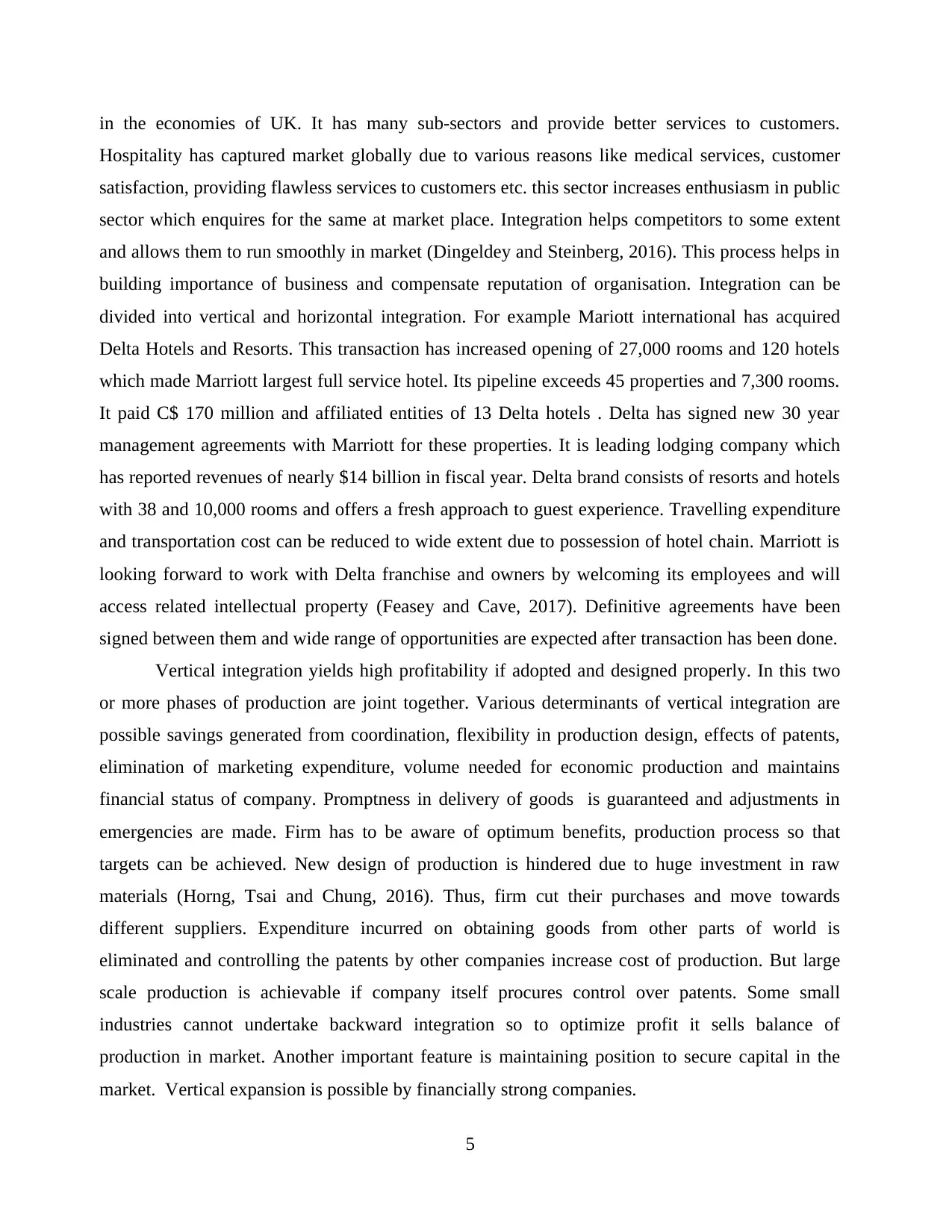
in the economies of UK. It has many sub-sectors and provide better services to customers.
Hospitality has captured market globally due to various reasons like medical services, customer
satisfaction, providing flawless services to customers etc. this sector increases enthusiasm in public
sector which enquires for the same at market place. Integration helps competitors to some extent
and allows them to run smoothly in market (Dingeldey and Steinberg, 2016). This process helps in
building importance of business and compensate reputation of organisation. Integration can be
divided into vertical and horizontal integration. For example Mariott international has acquired
Delta Hotels and Resorts. This transaction has increased opening of 27,000 rooms and 120 hotels
which made Marriott largest full service hotel. Its pipeline exceeds 45 properties and 7,300 rooms.
It paid C$ 170 million and affiliated entities of 13 Delta hotels . Delta has signed new 30 year
management agreements with Marriott for these properties. It is leading lodging company which
has reported revenues of nearly $14 billion in fiscal year. Delta brand consists of resorts and hotels
with 38 and 10,000 rooms and offers a fresh approach to guest experience. Travelling expenditure
and transportation cost can be reduced to wide extent due to possession of hotel chain. Marriott is
looking forward to work with Delta franchise and owners by welcoming its employees and will
access related intellectual property (Feasey and Cave, 2017). Definitive agreements have been
signed between them and wide range of opportunities are expected after transaction has been done.
Vertical integration yields high profitability if adopted and designed properly. In this two
or more phases of production are joint together. Various determinants of vertical integration are
possible savings generated from coordination, flexibility in production design, effects of patents,
elimination of marketing expenditure, volume needed for economic production and maintains
financial status of company. Promptness in delivery of goods is guaranteed and adjustments in
emergencies are made. Firm has to be aware of optimum benefits, production process so that
targets can be achieved. New design of production is hindered due to huge investment in raw
materials (Horng, Tsai and Chung, 2016). Thus, firm cut their purchases and move towards
different suppliers. Expenditure incurred on obtaining goods from other parts of world is
eliminated and controlling the patents by other companies increase cost of production. But large
scale production is achievable if company itself procures control over patents. Some small
industries cannot undertake backward integration so to optimize profit it sells balance of
production in market. Another important feature is maintaining position to secure capital in the
market. Vertical expansion is possible by financially strong companies.
5
Hospitality has captured market globally due to various reasons like medical services, customer
satisfaction, providing flawless services to customers etc. this sector increases enthusiasm in public
sector which enquires for the same at market place. Integration helps competitors to some extent
and allows them to run smoothly in market (Dingeldey and Steinberg, 2016). This process helps in
building importance of business and compensate reputation of organisation. Integration can be
divided into vertical and horizontal integration. For example Mariott international has acquired
Delta Hotels and Resorts. This transaction has increased opening of 27,000 rooms and 120 hotels
which made Marriott largest full service hotel. Its pipeline exceeds 45 properties and 7,300 rooms.
It paid C$ 170 million and affiliated entities of 13 Delta hotels . Delta has signed new 30 year
management agreements with Marriott for these properties. It is leading lodging company which
has reported revenues of nearly $14 billion in fiscal year. Delta brand consists of resorts and hotels
with 38 and 10,000 rooms and offers a fresh approach to guest experience. Travelling expenditure
and transportation cost can be reduced to wide extent due to possession of hotel chain. Marriott is
looking forward to work with Delta franchise and owners by welcoming its employees and will
access related intellectual property (Feasey and Cave, 2017). Definitive agreements have been
signed between them and wide range of opportunities are expected after transaction has been done.
Vertical integration yields high profitability if adopted and designed properly. In this two
or more phases of production are joint together. Various determinants of vertical integration are
possible savings generated from coordination, flexibility in production design, effects of patents,
elimination of marketing expenditure, volume needed for economic production and maintains
financial status of company. Promptness in delivery of goods is guaranteed and adjustments in
emergencies are made. Firm has to be aware of optimum benefits, production process so that
targets can be achieved. New design of production is hindered due to huge investment in raw
materials (Horng, Tsai and Chung, 2016). Thus, firm cut their purchases and move towards
different suppliers. Expenditure incurred on obtaining goods from other parts of world is
eliminated and controlling the patents by other companies increase cost of production. But large
scale production is achievable if company itself procures control over patents. Some small
industries cannot undertake backward integration so to optimize profit it sells balance of
production in market. Another important feature is maintaining position to secure capital in the
market. Vertical expansion is possible by financially strong companies.
5
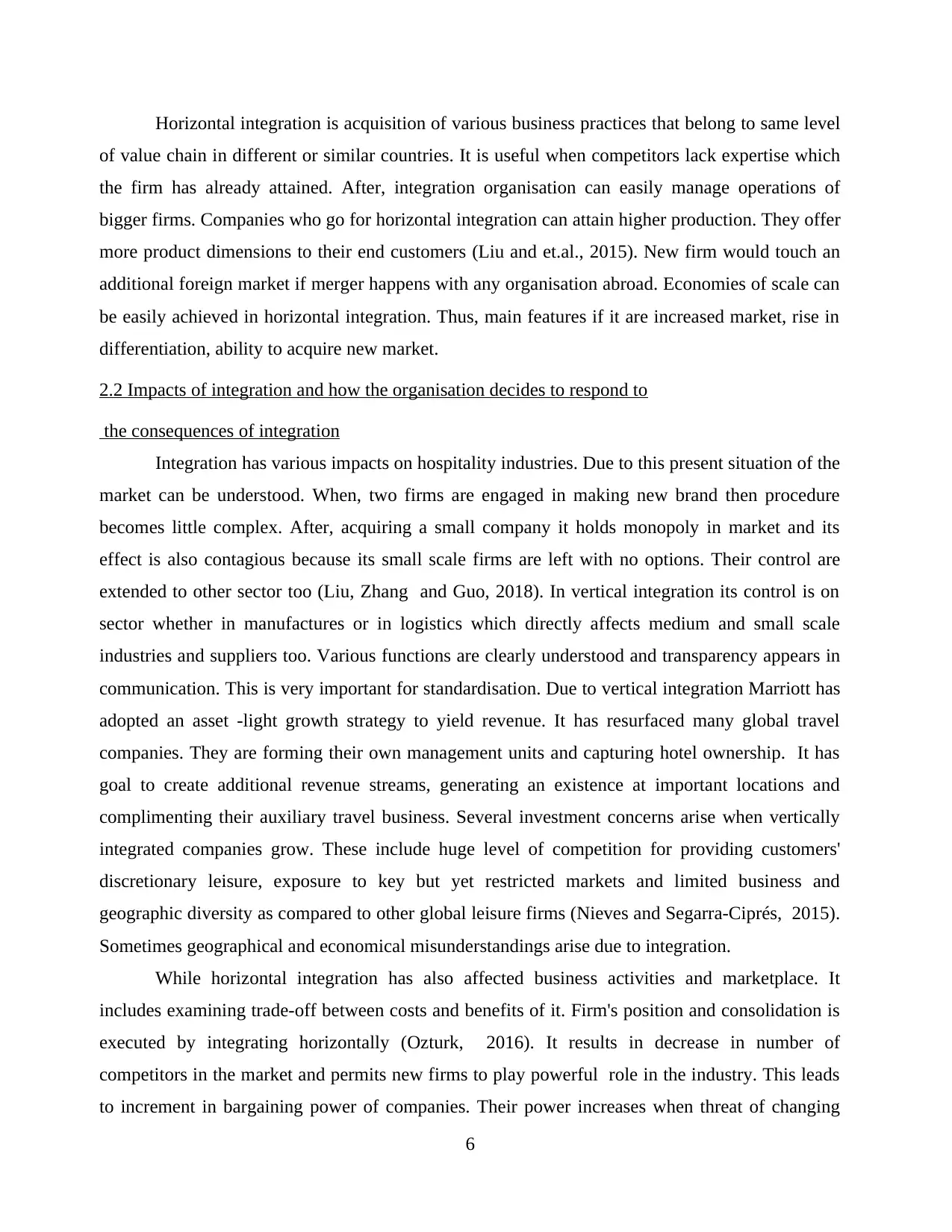
Horizontal integration is acquisition of various business practices that belong to same level
of value chain in different or similar countries. It is useful when competitors lack expertise which
the firm has already attained. After, integration organisation can easily manage operations of
bigger firms. Companies who go for horizontal integration can attain higher production. They offer
more product dimensions to their end customers (Liu and et.al., 2015). New firm would touch an
additional foreign market if merger happens with any organisation abroad. Economies of scale can
be easily achieved in horizontal integration. Thus, main features if it are increased market, rise in
differentiation, ability to acquire new market.
2.2 Impacts of integration and how the organisation decides to respond to
the consequences of integration
Integration has various impacts on hospitality industries. Due to this present situation of the
market can be understood. When, two firms are engaged in making new brand then procedure
becomes little complex. After, acquiring a small company it holds monopoly in market and its
effect is also contagious because its small scale firms are left with no options. Their control are
extended to other sector too (Liu, Zhang and Guo, 2018). In vertical integration its control is on
sector whether in manufactures or in logistics which directly affects medium and small scale
industries and suppliers too. Various functions are clearly understood and transparency appears in
communication. This is very important for standardisation. Due to vertical integration Marriott has
adopted an asset -light growth strategy to yield revenue. It has resurfaced many global travel
companies. They are forming their own management units and capturing hotel ownership. It has
goal to create additional revenue streams, generating an existence at important locations and
complimenting their auxiliary travel business. Several investment concerns arise when vertically
integrated companies grow. These include huge level of competition for providing customers'
discretionary leisure, exposure to key but yet restricted markets and limited business and
geographic diversity as compared to other global leisure firms (Nieves and Segarra-Ciprés, 2015).
Sometimes geographical and economical misunderstandings arise due to integration.
While horizontal integration has also affected business activities and marketplace. It
includes examining trade-off between costs and benefits of it. Firm's position and consolidation is
executed by integrating horizontally (Ozturk, 2016). It results in decrease in number of
competitors in the market and permits new firms to play powerful role in the industry. This leads
to increment in bargaining power of companies. Their power increases when threat of changing
6
of value chain in different or similar countries. It is useful when competitors lack expertise which
the firm has already attained. After, integration organisation can easily manage operations of
bigger firms. Companies who go for horizontal integration can attain higher production. They offer
more product dimensions to their end customers (Liu and et.al., 2015). New firm would touch an
additional foreign market if merger happens with any organisation abroad. Economies of scale can
be easily achieved in horizontal integration. Thus, main features if it are increased market, rise in
differentiation, ability to acquire new market.
2.2 Impacts of integration and how the organisation decides to respond to
the consequences of integration
Integration has various impacts on hospitality industries. Due to this present situation of the
market can be understood. When, two firms are engaged in making new brand then procedure
becomes little complex. After, acquiring a small company it holds monopoly in market and its
effect is also contagious because its small scale firms are left with no options. Their control are
extended to other sector too (Liu, Zhang and Guo, 2018). In vertical integration its control is on
sector whether in manufactures or in logistics which directly affects medium and small scale
industries and suppliers too. Various functions are clearly understood and transparency appears in
communication. This is very important for standardisation. Due to vertical integration Marriott has
adopted an asset -light growth strategy to yield revenue. It has resurfaced many global travel
companies. They are forming their own management units and capturing hotel ownership. It has
goal to create additional revenue streams, generating an existence at important locations and
complimenting their auxiliary travel business. Several investment concerns arise when vertically
integrated companies grow. These include huge level of competition for providing customers'
discretionary leisure, exposure to key but yet restricted markets and limited business and
geographic diversity as compared to other global leisure firms (Nieves and Segarra-Ciprés, 2015).
Sometimes geographical and economical misunderstandings arise due to integration.
While horizontal integration has also affected business activities and marketplace. It
includes examining trade-off between costs and benefits of it. Firm's position and consolidation is
executed by integrating horizontally (Ozturk, 2016). It results in decrease in number of
competitors in the market and permits new firms to play powerful role in the industry. This leads
to increment in bargaining power of companies. Their power increases when threat of changing
6
⊘ This is a preview!⊘
Do you want full access?
Subscribe today to unlock all pages.

Trusted by 1+ million students worldwide

suppliers dies and there is reduction in the demands of customers. Firms are capable to target new
economies of scale which involves maximizing prices and reducing costs that results in increase in
profitability. Integration affects business in following ways:
Standardisation: It is huge and complicated process that is easy to handle but involves many
human components which makes it tangled. Marriott has a tough standardisation procedure and
customers are very well greeted at every level wherever they visit (Pechlaner, Kozak and Volgger,
2014). They feel glad find same kind of environment. For the application of standardization firm
has to be efficient, hard and strict in their functioning.
Economic Scale: Due to integration operating cost is reduced to a level. If any travel agency takes
over hotel then initial investment is increase perhaps. Services provided in initial years would
result in lots of benefits and emergence of tourism.
Quality: It is not guaranteed in integration process. It just relies on the elements included.
Companies try to provide quality wise services to customers. Managers and leaders try to fulfil
their demand on time. Moreover, it has influenced operations of firms vastly. Customers get
various benefits when integration takes place (Qiu, 2017). It results in decrease in competition due
to which customers are left with few options. Integrated firms then try to create monopoly in the
market due to which profit maximization takes place. Revenues and incomes are increased and all
kinds of costs and expenses are bear by one company. Their sole objective is to expand business to
various other parts of the world and deliver best services to tourists. These companies follow
various plans, procedures and strategies. When merger takes place these strategies and plans are
driven by single authority.
TASK 3
3.1 & 3.2 Rationale of new hospitality business outlining product service concept and project
proposal
In current scenario hospitality business is becoming more effective and operating in various
ways. Its outcomes are mainly emphasized to work on departments and customer service. Thus,
more opportunities grow up which invite other businesses to enter in it (Russo and Quaglieri,
2016). A proper business development plan has to be considered to start a new enterprise:
7
economies of scale which involves maximizing prices and reducing costs that results in increase in
profitability. Integration affects business in following ways:
Standardisation: It is huge and complicated process that is easy to handle but involves many
human components which makes it tangled. Marriott has a tough standardisation procedure and
customers are very well greeted at every level wherever they visit (Pechlaner, Kozak and Volgger,
2014). They feel glad find same kind of environment. For the application of standardization firm
has to be efficient, hard and strict in their functioning.
Economic Scale: Due to integration operating cost is reduced to a level. If any travel agency takes
over hotel then initial investment is increase perhaps. Services provided in initial years would
result in lots of benefits and emergence of tourism.
Quality: It is not guaranteed in integration process. It just relies on the elements included.
Companies try to provide quality wise services to customers. Managers and leaders try to fulfil
their demand on time. Moreover, it has influenced operations of firms vastly. Customers get
various benefits when integration takes place (Qiu, 2017). It results in decrease in competition due
to which customers are left with few options. Integrated firms then try to create monopoly in the
market due to which profit maximization takes place. Revenues and incomes are increased and all
kinds of costs and expenses are bear by one company. Their sole objective is to expand business to
various other parts of the world and deliver best services to tourists. These companies follow
various plans, procedures and strategies. When merger takes place these strategies and plans are
driven by single authority.
TASK 3
3.1 & 3.2 Rationale of new hospitality business outlining product service concept and project
proposal
In current scenario hospitality business is becoming more effective and operating in various
ways. Its outcomes are mainly emphasized to work on departments and customer service. Thus,
more opportunities grow up which invite other businesses to enter in it (Russo and Quaglieri,
2016). A proper business development plan has to be considered to start a new enterprise:
7
Paraphrase This Document
Need a fresh take? Get an instant paraphrase of this document with our AI Paraphraser
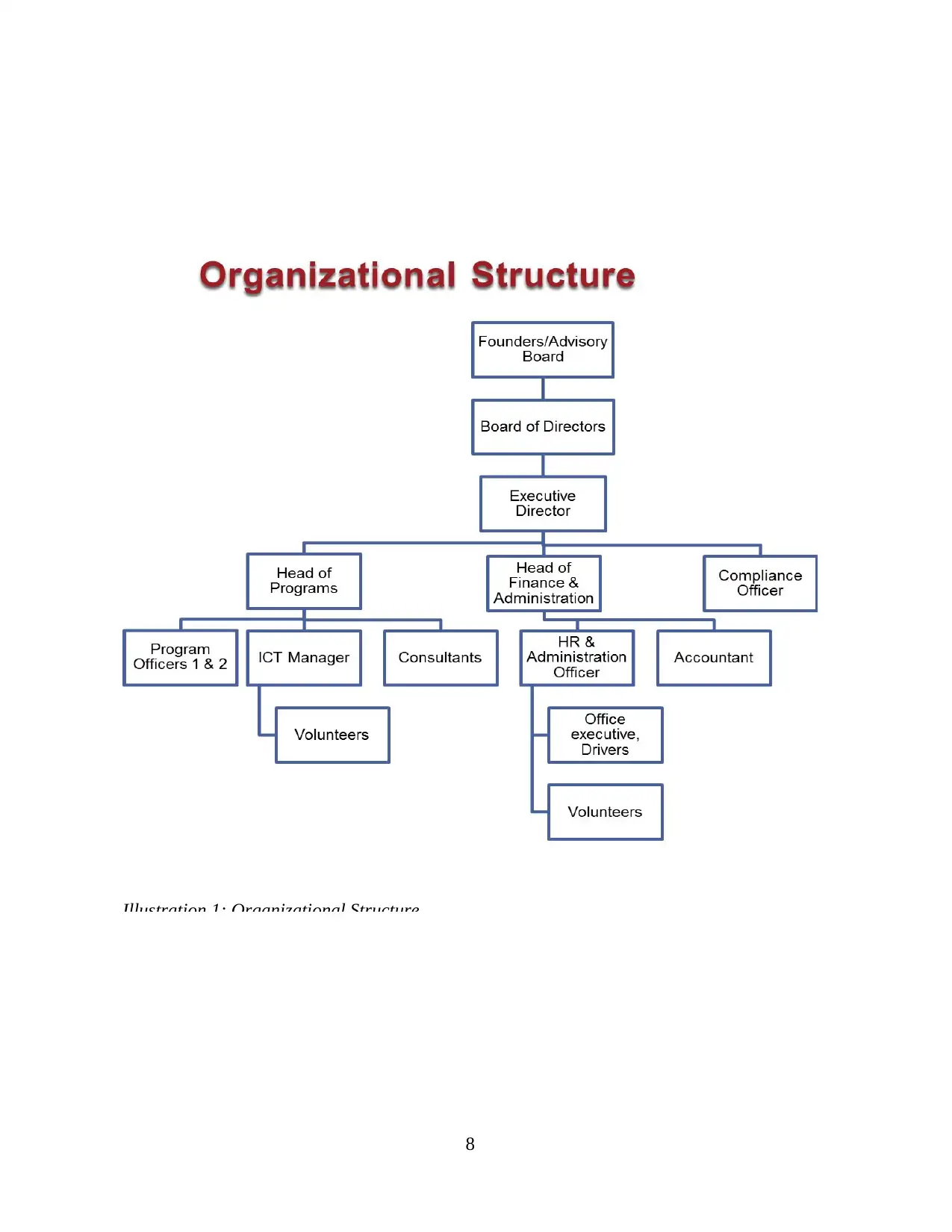
8
Illustration 1: Organizational Structure
Illustration 1: Organizational Structure
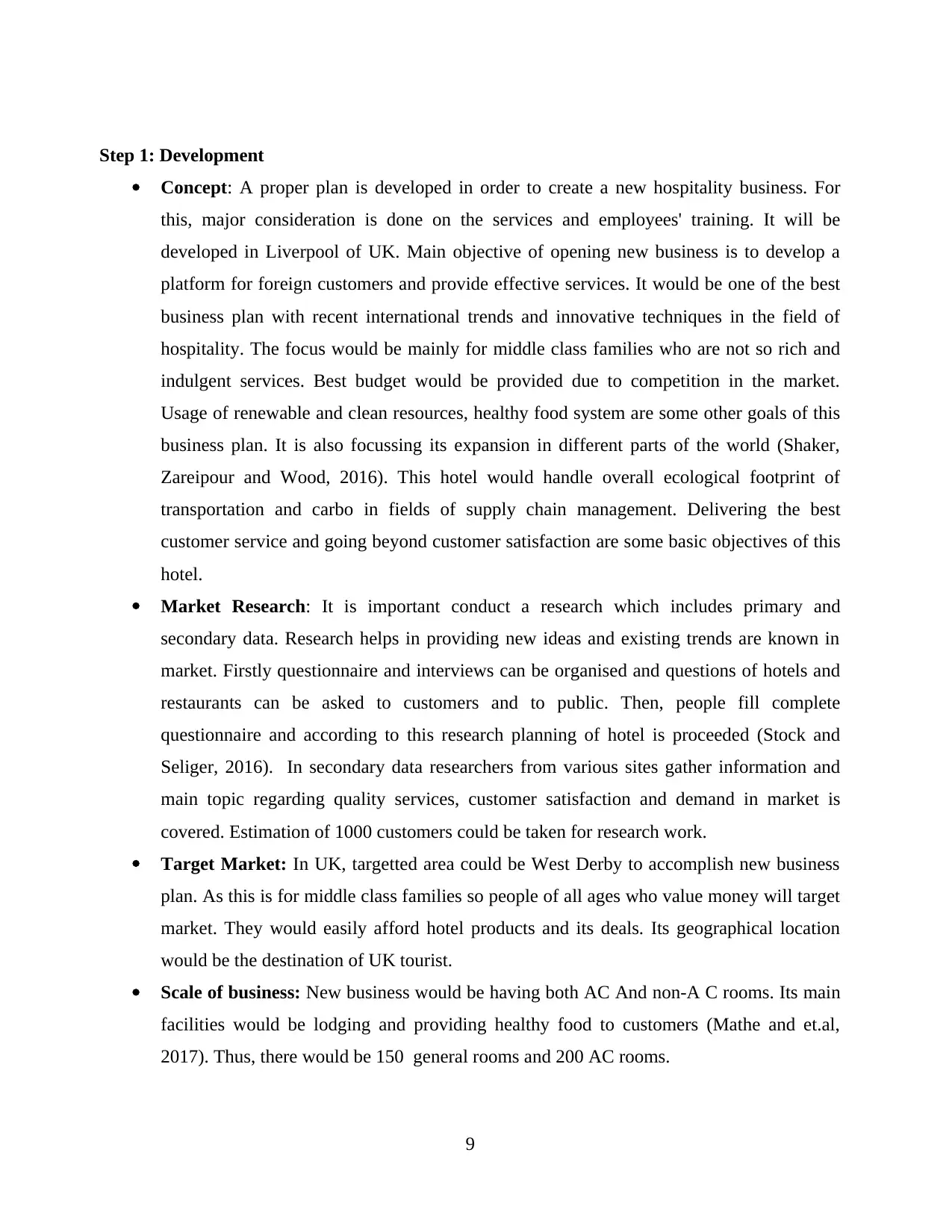
Step 1: Development
Concept: A proper plan is developed in order to create a new hospitality business. For
this, major consideration is done on the services and employees' training. It will be
developed in Liverpool of UK. Main objective of opening new business is to develop a
platform for foreign customers and provide effective services. It would be one of the best
business plan with recent international trends and innovative techniques in the field of
hospitality. The focus would be mainly for middle class families who are not so rich and
indulgent services. Best budget would be provided due to competition in the market.
Usage of renewable and clean resources, healthy food system are some other goals of this
business plan. It is also focussing its expansion in different parts of the world (Shaker,
Zareipour and Wood, 2016). This hotel would handle overall ecological footprint of
transportation and carbo in fields of supply chain management. Delivering the best
customer service and going beyond customer satisfaction are some basic objectives of this
hotel.
Market Research: It is important conduct a research which includes primary and
secondary data. Research helps in providing new ideas and existing trends are known in
market. Firstly questionnaire and interviews can be organised and questions of hotels and
restaurants can be asked to customers and to public. Then, people fill complete
questionnaire and according to this research planning of hotel is proceeded (Stock and
Seliger, 2016). In secondary data researchers from various sites gather information and
main topic regarding quality services, customer satisfaction and demand in market is
covered. Estimation of 1000 customers could be taken for research work.
Target Market: In UK, targetted area could be West Derby to accomplish new business
plan. As this is for middle class families so people of all ages who value money will target
market. They would easily afford hotel products and its deals. Its geographical location
would be the destination of UK tourist.
Scale of business: New business would be having both AC And non-A C rooms. Its main
facilities would be lodging and providing healthy food to customers (Mathe and et.al,
2017). Thus, there would be 150 general rooms and 200 AC rooms.
9
Concept: A proper plan is developed in order to create a new hospitality business. For
this, major consideration is done on the services and employees' training. It will be
developed in Liverpool of UK. Main objective of opening new business is to develop a
platform for foreign customers and provide effective services. It would be one of the best
business plan with recent international trends and innovative techniques in the field of
hospitality. The focus would be mainly for middle class families who are not so rich and
indulgent services. Best budget would be provided due to competition in the market.
Usage of renewable and clean resources, healthy food system are some other goals of this
business plan. It is also focussing its expansion in different parts of the world (Shaker,
Zareipour and Wood, 2016). This hotel would handle overall ecological footprint of
transportation and carbo in fields of supply chain management. Delivering the best
customer service and going beyond customer satisfaction are some basic objectives of this
hotel.
Market Research: It is important conduct a research which includes primary and
secondary data. Research helps in providing new ideas and existing trends are known in
market. Firstly questionnaire and interviews can be organised and questions of hotels and
restaurants can be asked to customers and to public. Then, people fill complete
questionnaire and according to this research planning of hotel is proceeded (Stock and
Seliger, 2016). In secondary data researchers from various sites gather information and
main topic regarding quality services, customer satisfaction and demand in market is
covered. Estimation of 1000 customers could be taken for research work.
Target Market: In UK, targetted area could be West Derby to accomplish new business
plan. As this is for middle class families so people of all ages who value money will target
market. They would easily afford hotel products and its deals. Its geographical location
would be the destination of UK tourist.
Scale of business: New business would be having both AC And non-A C rooms. Its main
facilities would be lodging and providing healthy food to customers (Mathe and et.al,
2017). Thus, there would be 150 general rooms and 200 AC rooms.
9
⊘ This is a preview!⊘
Do you want full access?
Subscribe today to unlock all pages.

Trusted by 1+ million students worldwide
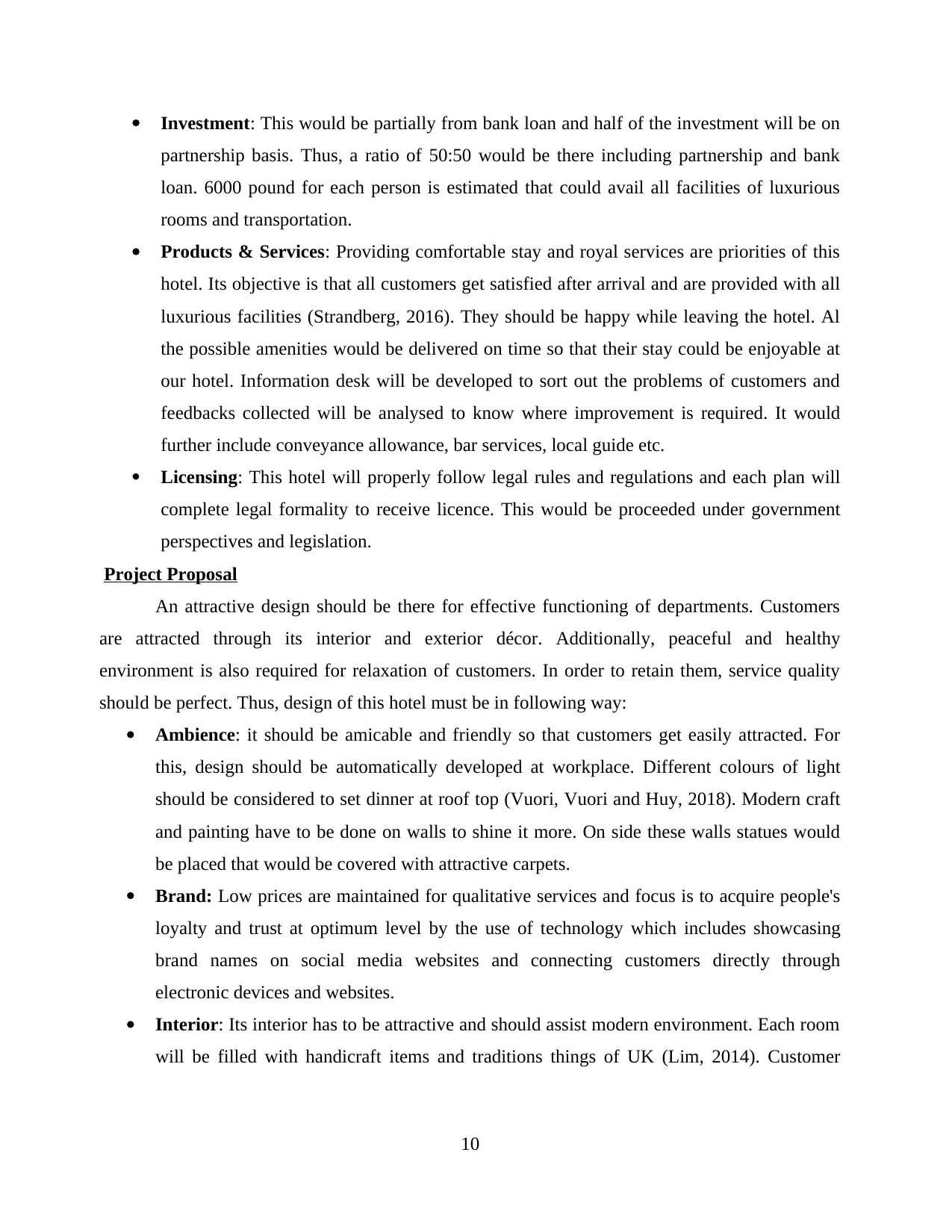
Investment: This would be partially from bank loan and half of the investment will be on
partnership basis. Thus, a ratio of 50:50 would be there including partnership and bank
loan. 6000 pound for each person is estimated that could avail all facilities of luxurious
rooms and transportation.
Products & Services: Providing comfortable stay and royal services are priorities of this
hotel. Its objective is that all customers get satisfied after arrival and are provided with all
luxurious facilities (Strandberg, 2016). They should be happy while leaving the hotel. Al
the possible amenities would be delivered on time so that their stay could be enjoyable at
our hotel. Information desk will be developed to sort out the problems of customers and
feedbacks collected will be analysed to know where improvement is required. It would
further include conveyance allowance, bar services, local guide etc.
Licensing: This hotel will properly follow legal rules and regulations and each plan will
complete legal formality to receive licence. This would be proceeded under government
perspectives and legislation.
Project Proposal
An attractive design should be there for effective functioning of departments. Customers
are attracted through its interior and exterior décor. Additionally, peaceful and healthy
environment is also required for relaxation of customers. In order to retain them, service quality
should be perfect. Thus, design of this hotel must be in following way:
Ambience: it should be amicable and friendly so that customers get easily attracted. For
this, design should be automatically developed at workplace. Different colours of light
should be considered to set dinner at roof top (Vuori, Vuori and Huy, 2018). Modern craft
and painting have to be done on walls to shine it more. On side these walls statues would
be placed that would be covered with attractive carpets.
Brand: Low prices are maintained for qualitative services and focus is to acquire people's
loyalty and trust at optimum level by the use of technology which includes showcasing
brand names on social media websites and connecting customers directly through
electronic devices and websites.
Interior: Its interior has to be attractive and should assist modern environment. Each room
will be filled with handicraft items and traditions things of UK (Lim, 2014). Customer
10
partnership basis. Thus, a ratio of 50:50 would be there including partnership and bank
loan. 6000 pound for each person is estimated that could avail all facilities of luxurious
rooms and transportation.
Products & Services: Providing comfortable stay and royal services are priorities of this
hotel. Its objective is that all customers get satisfied after arrival and are provided with all
luxurious facilities (Strandberg, 2016). They should be happy while leaving the hotel. Al
the possible amenities would be delivered on time so that their stay could be enjoyable at
our hotel. Information desk will be developed to sort out the problems of customers and
feedbacks collected will be analysed to know where improvement is required. It would
further include conveyance allowance, bar services, local guide etc.
Licensing: This hotel will properly follow legal rules and regulations and each plan will
complete legal formality to receive licence. This would be proceeded under government
perspectives and legislation.
Project Proposal
An attractive design should be there for effective functioning of departments. Customers
are attracted through its interior and exterior décor. Additionally, peaceful and healthy
environment is also required for relaxation of customers. In order to retain them, service quality
should be perfect. Thus, design of this hotel must be in following way:
Ambience: it should be amicable and friendly so that customers get easily attracted. For
this, design should be automatically developed at workplace. Different colours of light
should be considered to set dinner at roof top (Vuori, Vuori and Huy, 2018). Modern craft
and painting have to be done on walls to shine it more. On side these walls statues would
be placed that would be covered with attractive carpets.
Brand: Low prices are maintained for qualitative services and focus is to acquire people's
loyalty and trust at optimum level by the use of technology which includes showcasing
brand names on social media websites and connecting customers directly through
electronic devices and websites.
Interior: Its interior has to be attractive and should assist modern environment. Each room
will be filled with handicraft items and traditions things of UK (Lim, 2014). Customer
10
Paraphrase This Document
Need a fresh take? Get an instant paraphrase of this document with our AI Paraphraser
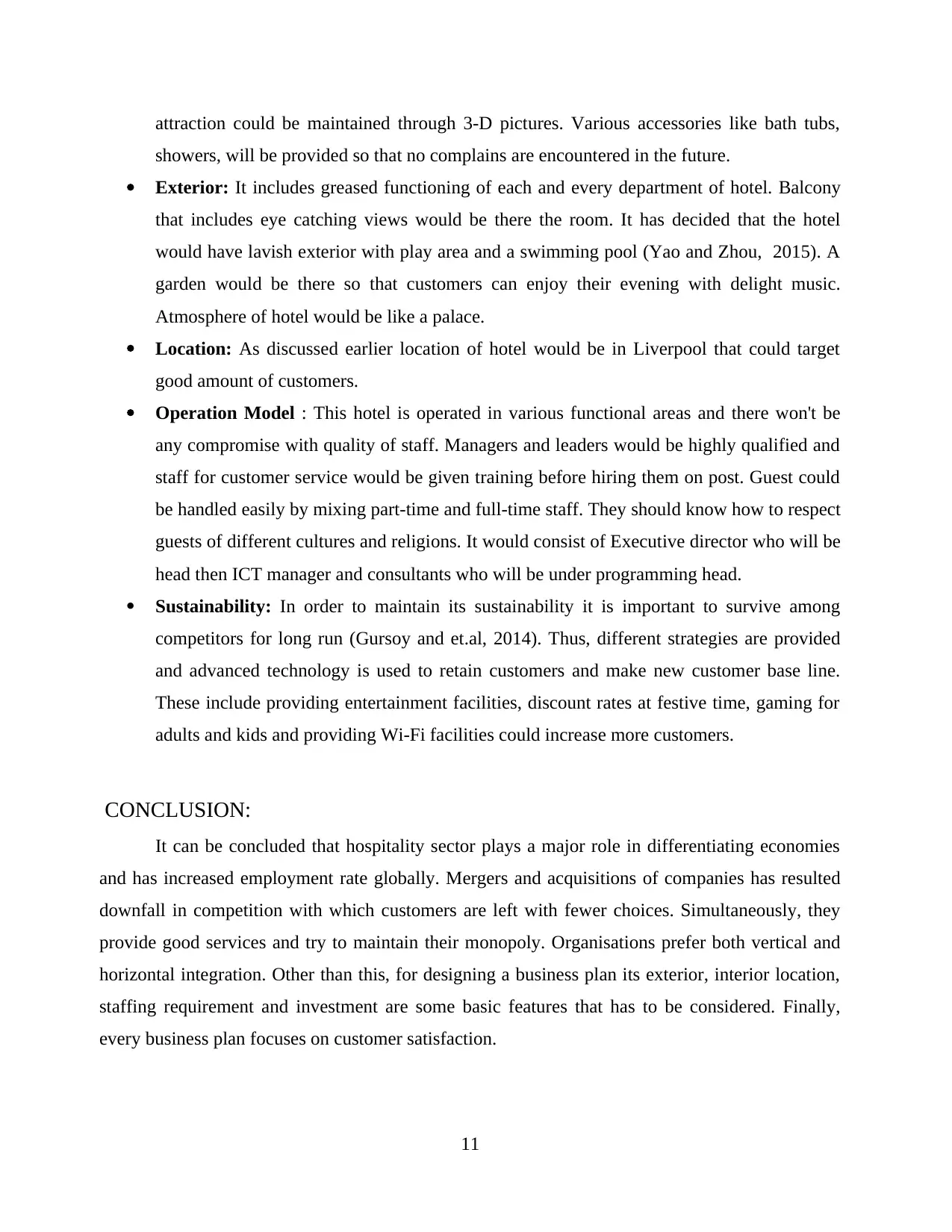
attraction could be maintained through 3-D pictures. Various accessories like bath tubs,
showers, will be provided so that no complains are encountered in the future.
Exterior: It includes greased functioning of each and every department of hotel. Balcony
that includes eye catching views would be there the room. It has decided that the hotel
would have lavish exterior with play area and a swimming pool (Yao and Zhou, 2015). A
garden would be there so that customers can enjoy their evening with delight music.
Atmosphere of hotel would be like a palace.
Location: As discussed earlier location of hotel would be in Liverpool that could target
good amount of customers.
Operation Model : This hotel is operated in various functional areas and there won't be
any compromise with quality of staff. Managers and leaders would be highly qualified and
staff for customer service would be given training before hiring them on post. Guest could
be handled easily by mixing part-time and full-time staff. They should know how to respect
guests of different cultures and religions. It would consist of Executive director who will be
head then ICT manager and consultants who will be under programming head.
Sustainability: In order to maintain its sustainability it is important to survive among
competitors for long run (Gursoy and et.al, 2014). Thus, different strategies are provided
and advanced technology is used to retain customers and make new customer base line.
These include providing entertainment facilities, discount rates at festive time, gaming for
adults and kids and providing Wi-Fi facilities could increase more customers.
CONCLUSION:
It can be concluded that hospitality sector plays a major role in differentiating economies
and has increased employment rate globally. Mergers and acquisitions of companies has resulted
downfall in competition with which customers are left with fewer choices. Simultaneously, they
provide good services and try to maintain their monopoly. Organisations prefer both vertical and
horizontal integration. Other than this, for designing a business plan its exterior, interior location,
staffing requirement and investment are some basic features that has to be considered. Finally,
every business plan focuses on customer satisfaction.
11
showers, will be provided so that no complains are encountered in the future.
Exterior: It includes greased functioning of each and every department of hotel. Balcony
that includes eye catching views would be there the room. It has decided that the hotel
would have lavish exterior with play area and a swimming pool (Yao and Zhou, 2015). A
garden would be there so that customers can enjoy their evening with delight music.
Atmosphere of hotel would be like a palace.
Location: As discussed earlier location of hotel would be in Liverpool that could target
good amount of customers.
Operation Model : This hotel is operated in various functional areas and there won't be
any compromise with quality of staff. Managers and leaders would be highly qualified and
staff for customer service would be given training before hiring them on post. Guest could
be handled easily by mixing part-time and full-time staff. They should know how to respect
guests of different cultures and religions. It would consist of Executive director who will be
head then ICT manager and consultants who will be under programming head.
Sustainability: In order to maintain its sustainability it is important to survive among
competitors for long run (Gursoy and et.al, 2014). Thus, different strategies are provided
and advanced technology is used to retain customers and make new customer base line.
These include providing entertainment facilities, discount rates at festive time, gaming for
adults and kids and providing Wi-Fi facilities could increase more customers.
CONCLUSION:
It can be concluded that hospitality sector plays a major role in differentiating economies
and has increased employment rate globally. Mergers and acquisitions of companies has resulted
downfall in competition with which customers are left with fewer choices. Simultaneously, they
provide good services and try to maintain their monopoly. Organisations prefer both vertical and
horizontal integration. Other than this, for designing a business plan its exterior, interior location,
staffing requirement and investment are some basic features that has to be considered. Finally,
every business plan focuses on customer satisfaction.
11

REFERENCES:
Alfaro and et.al., 2016. Do prices determine vertical integration?. The Review of Economic
Studies. 83(3). pp.855-888.
Andringa, S., Poulston, J. and Pernecky, T., 2016. Hospitality entrepreneurship: a link in the career
chain. International Journal of Contemporary Hospitality Management. 28(4). pp.717-736.
Bavik, A., 2016. Developing a new hospitality industry organizational culture scale. International
Journal of Hospitality Management. 58. pp.44-55.
Bui and et.al., 2016. Impacts of Economic Integration on Living Standards and Poverty Reduction
of Rural Households.
Cook, R.A., Hsu, C.H. and Marqua, J.J., 2014. Tourism: the business of hospitality and travel.
Boston, MA: Pearson.
Dingeldey, I. and Steinberg, L., 2016. Strategies to improve labour market integration of young
people: Analysing linkages between horizontal and vertical policy coordination.
Feasey, R. and Cave, M., 2017. Policy towards competition in high-speed broadband in Europe, in
an age of vertical and horizontal integration and oligopolies.
Horng, J.S., Tsai, C.Y. and Chung, Y.C., 2016. Measuring practitioners’ creativity in the
Taiwanese tourism and hospitality industry. Thinking Skills and Creativity. 19. pp.269-278.
Liu and et.al., 2015. Systems integration for global sustainability. Science. 347(6225). p.1258832.
Liu, G., Zhang, W. and Guo, C., 2018. Impacts of supply chain planning and integration on mass
customization. Journal of Manufacturing Technology Management. 29(3). pp.608-628.
Nieves, J. and Segarra-Ciprés, M., 2015. Management innovation in the hotel industry. Tourism
Management. 46. pp.51-58.
Ozturk, A.B., 2016. Customer acceptance of cashless payment systems in the hospitality industry.
International Journal of Contemporary Hospitality Management. 28(4). pp.801-817.
Pechlaner, H., Kozak, M. and Volgger, M., 2014. Destination leadership: a new paradigm for
tourist destinations?. Tourism Review. 69(1). pp.1-9.
Qiu, L.D., 2017. Impacts of Trade Liberalization on Vertical Integration: Evidence from China. In
The 9th Annual Conference of International Economics and Finance (China).
Russo, A.P. and Quaglieri, A., 2016. The shifting spatial logic of tourism in networked hospitality.
Reinventing the Local in Tourism: Producing, Consuming and Negotiating Place. 73. p.15.
12
Alfaro and et.al., 2016. Do prices determine vertical integration?. The Review of Economic
Studies. 83(3). pp.855-888.
Andringa, S., Poulston, J. and Pernecky, T., 2016. Hospitality entrepreneurship: a link in the career
chain. International Journal of Contemporary Hospitality Management. 28(4). pp.717-736.
Bavik, A., 2016. Developing a new hospitality industry organizational culture scale. International
Journal of Hospitality Management. 58. pp.44-55.
Bui and et.al., 2016. Impacts of Economic Integration on Living Standards and Poverty Reduction
of Rural Households.
Cook, R.A., Hsu, C.H. and Marqua, J.J., 2014. Tourism: the business of hospitality and travel.
Boston, MA: Pearson.
Dingeldey, I. and Steinberg, L., 2016. Strategies to improve labour market integration of young
people: Analysing linkages between horizontal and vertical policy coordination.
Feasey, R. and Cave, M., 2017. Policy towards competition in high-speed broadband in Europe, in
an age of vertical and horizontal integration and oligopolies.
Horng, J.S., Tsai, C.Y. and Chung, Y.C., 2016. Measuring practitioners’ creativity in the
Taiwanese tourism and hospitality industry. Thinking Skills and Creativity. 19. pp.269-278.
Liu and et.al., 2015. Systems integration for global sustainability. Science. 347(6225). p.1258832.
Liu, G., Zhang, W. and Guo, C., 2018. Impacts of supply chain planning and integration on mass
customization. Journal of Manufacturing Technology Management. 29(3). pp.608-628.
Nieves, J. and Segarra-Ciprés, M., 2015. Management innovation in the hotel industry. Tourism
Management. 46. pp.51-58.
Ozturk, A.B., 2016. Customer acceptance of cashless payment systems in the hospitality industry.
International Journal of Contemporary Hospitality Management. 28(4). pp.801-817.
Pechlaner, H., Kozak, M. and Volgger, M., 2014. Destination leadership: a new paradigm for
tourist destinations?. Tourism Review. 69(1). pp.1-9.
Qiu, L.D., 2017. Impacts of Trade Liberalization on Vertical Integration: Evidence from China. In
The 9th Annual Conference of International Economics and Finance (China).
Russo, A.P. and Quaglieri, A., 2016. The shifting spatial logic of tourism in networked hospitality.
Reinventing the Local in Tourism: Producing, Consuming and Negotiating Place. 73. p.15.
12
⊘ This is a preview!⊘
Do you want full access?
Subscribe today to unlock all pages.

Trusted by 1+ million students worldwide
1 out of 13
Related Documents
Your All-in-One AI-Powered Toolkit for Academic Success.
+13062052269
info@desklib.com
Available 24*7 on WhatsApp / Email
![[object Object]](/_next/static/media/star-bottom.7253800d.svg)
Unlock your academic potential
Copyright © 2020–2025 A2Z Services. All Rights Reserved. Developed and managed by ZUCOL.





